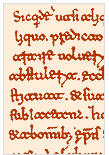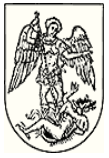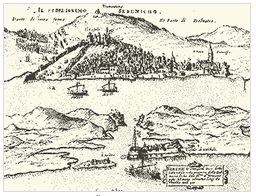Origin and development at the time of Croatian national leaders

Arriving Croats built a fortress (castrum) of Šibenik on the western side of a Karst agrarian areas called Gornje and Donje polje, on a stony rise 70m above the sea. The fortress was located on the south coast of a natural port and primarily served as administrative, religious and defence post of the county. Historical sources do not reveal the precise time of the fortress foundation but it is almost certain that it took place in IX century, at the latest. Parallel with the development of medieval Croatian state an urban settlement was being built beneath Šibenik fortress. Šibenik is first mentioned in deed of gift made by King Petar Krešimir IV (1058-1074), who at the time lived and discussed state matters in Šibenik.
Šibenik as a part of Hungarian–Croatian state

Croatia entered a state community with Hungary in 1102 after Hungarian King Ladislav’s military and politic intervention. With this act, Croatian and Hungarian kings became sovereigns of Šibenik as well. This period (XII –XV ct) is characterized by frequent changes in the town sovereignty, from Croatian- Hungarian leaders and home knights, over Byzantium and Middle Age Bosnian state to Venice (on several occasions). Despite these changes the town continued to grow and prosper. In 1298 pope Bonifatio VIII issued a bill proclaiming Šibenik a city and ordering for a diocese to be established. In 1409 Ladislav of Naples sold Venice his royal rights in Dalmatia for 100 000 golden ducats. Soon afterwards Venetians arrived before Šibenik demanding surrender. The town refused to give in to the ultimatum and managed to resist Venetian assaults for three years. On 30 th October 1412, exhausted by the siege, the town was forced to bring their resistance to an end and surrender.
400 years under Venetian rule

Under Venetian rule Šibenik was given the status of autonomous town commune. Nonetheless the autonomy was systematically obstructed and limited. Venetians cancelled free election of the town’s prince and appointed one from their own ranks. Grand Council of Šibenik was stripped of its legal and political power and submitted to the town’s prince. From XV ct. onwards, a new danger threatened Šibenik – the Turks and their expansion towards west. Ottoman Turks tried to conquer the city on several occasions (1570, 1647, 1659) but failed each time. In the year 1608 Šibenik issued its first constitution that originated at the beginning of XV ct. In 1649 the largest outbreak of plague emerged and killed three quarters of the town population. With the fall of Venetian state the town management decided to abrogate Venetian governing of the town and place it under the rule of Franjo II, Croatian-Hungarian king and Austrian emperor (Tsar).
Austrian and French government 1797-1813, 1797-1805
Under the Austrian rule Šibenik maintained its status of a district and county centre. Losing the war with France , Austria had to hand over its government in Dalmatia to France . French army entered Šibenik on 18 th February 1806. With the foundation of Illyrian province Šibenik became one of the districts in Dalmatia . Following Napoleon’s fall at Leipzig , Austrian army moved on to conquer southern Croatia and by 1 st November 1813 marched into Šibenik.
The second Austrian rule
Under the Austrian rule, as a part of a Kingdom of Dalmatia , Šibenik was a county centre with local government and its governor. Politic fight revolved around two parties, Italy – oriented Autonomaška and Croatian Popular Party. Later on Croatian Right’s Party joined them and by 1904 took over the district’s administration. Town grew and prospered: in 1879 water supply station was put in work, in 1883 hospital and in 1895 hydroelectric plan was built on the river Krka. Town population in 1900 was 10000. As soon as the First World War began Austrian government introduced a strict military–police regime which lasted until the fall of Austro-Hungary in 1918. In 1918 Popular Council declared the end of Austrian government and made Šibenik a part of the State of Slovenians , Croats and Serbs.
In the Yugoslav state 1921-1941
Between the two World Wars the role of Šibenik as a seaport and transit centre grew. It became even more important as the Lika railway from Šibenik to Zagreb was put in work in 1925. Political life evolved in constant fight against the great Serbian Unitarian regime of Yugoslavia . Šibenik citizens gathered around Stjepan Radić in Croatian Peasants Party (later lead by Vlatko Maček). In 1941 Germany and Italy attacked and occupied Yugoslav Kingdom . On 15 th of April Italian and German troops marched into Šibenik without encountering resistance and occupied the entire area.
Second World War period
With the establishment of Italian fascist government began the decentralization and Italianisation of Šibenik. In the town and surrounding villages more and more resistance and antifascist movements were being formed. After Italian capitulation in 1943 German troops invaded Šibenik and held it under their rule for fourteen months. After three-days’ combat against German troops in the town outskirts, partisan troops entered Šibenik on 3 rd November 1944.
In period from 1945- 1990
The Second World War left Šibenik as a part of Croatian federal politic unit in communist Yugoslavian state. In mid 60s Šibenik became one of the centres of industrial production and a large Adriatic port. In comparison to the one in IX ct, its urban agglomeration in the 60s increased manifold. As far as the economy is concerned, thanks to the beauties of Šibenik aquatorium and the river Krka, tourism flourished. Grand tourist complexes were built in Primošten, Vodice, Solaris and a rapid economic development ensued. The advancement of tourism was present not only along the coast but in the city itself, thanks to its historical and cultural tradition.
Independent state of Croatia
Collapse of the communist regime throughout Europe sped up fall of the communist state of Yugoslavia . After the referendum on 25 th June 1991, the Parliament suspended all ties to Yugoslavia and declared independency. Šibenik celebrated this historic event for Croatian people. However, soon afterwards it was attacked by the strong Yugoslav army and Serbian paramilitary units. Šibenik citizens chose to fight. Although under-armed, Croatian army and the people of Šibenik managed to defend the city. The battle that lasted for six days (16 th –22 nd September) was later known as the “September battle”. Major part of the county was still occupied by the Serbian forces and the town under heavy artillery attacks. In August 1995 in a military action named “Oluja” (“The Storm”) Croatian army defeated Serbian forces and freed the occupied areas. Šibenik became a free city, which created the basic conditions for its post-war recovery and it continued to develop as the centre of Šibenik-Knin county.
